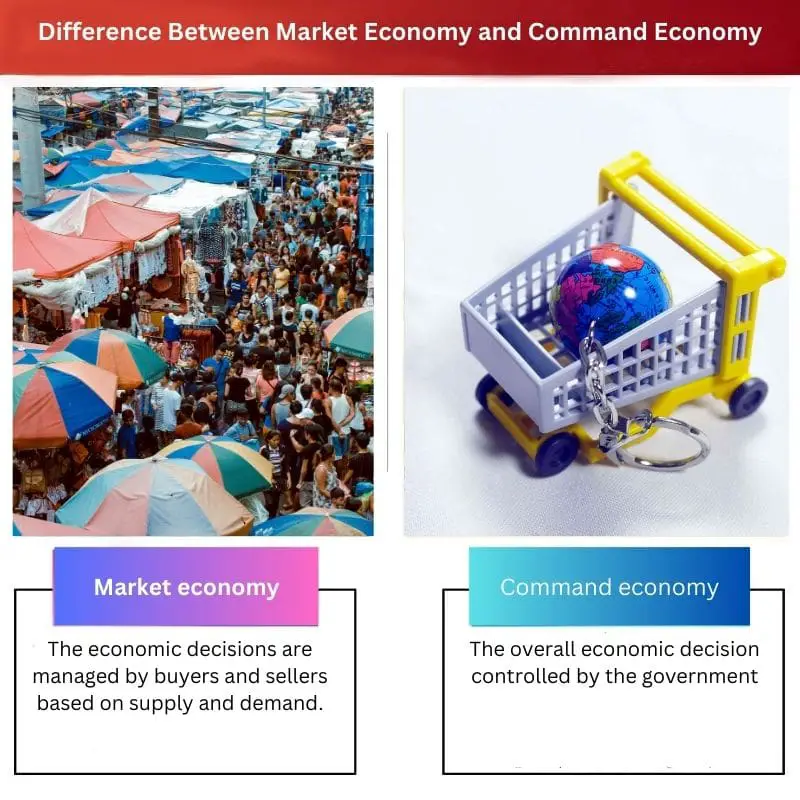Market Economy: In a market economy, decisions regarding production, distribution, and pricing are driven by the forces of supply and demand. Private individuals and businesses make choices based on market conditions, leading to decentralized decision-making and competition. Command Economy: In a command economy, the government centrally plans and controls economic activities. Authorities dictate what goods and services are produced, how they are allocated, and set prices. This centralized approach aims to achieve specific social or economic goals but may lack the efficiency and flexibility of market systems.
Key Takeaways
- A market economy is an economic system in which supply and demand determine the production and distribution of goods and services, with limited government intervention.
- A command economy is an economic system where the government controls the production and distribution of goods and services, making major economic decisions centrally.
- Market economies emphasize individual freedom and efficiency through competition, while command economies focus on centralized planning and control to meet broader societal goals.
Market Economy vs Command Economy
The difference between the market economy and the command economy is that it is an economic system managed by individuals or businesses that make financial decisions. At the same time, the command economy is a system where the government makes economic choices.

The market economy is one of the economic systems where the financial decision is taken by individuals or private sectors, such as the price and supply of goods.
The command economy is another economic system where the government will take the financial decision as to what and how to produce goods. It will not depend on the law of supply and demand as the market economy does.
Comparison Table
| Feature | Market Economy | Command Economy |
|---|---|---|
| Ownership of Resources | Private ownership | Government ownership |
| Decision Making | Driven by supply and demand | Centrally planned by the government |
| Motivation | Profit and self-interest | Social good and government objectives |
| Price and Wage Setting | Determined by supply and demand | Set by the government |
| Resource Allocation | Based on consumer preferences | Based on government priorities |
| Efficiency | Aims for allocative and productive efficiency (may experience periods of unemployment) | May experience shortages and inefficiency |
| Innovation | Driven by competition and profit motive | Limited by central planning |
| Standard of Living | Potential for high standard of living with wide variety of goods and services | May have lower standard of living with limited choices |
| Income Distribution | Tends to be more unequal | Can aim for more equal distribution, but may sacrifice economic growth |
| Government Role | Limited to providing public goods, regulating markets, and safety nets | Extensive control over resource allocation, production, and prices |
| Examples | United States, Japan, Germany | North Korea, Cuba (formerly), Soviet Union (formerly) |
What is Market Economy?
Characteristics of a Market Economy
1. Private Ownership
In a market economy, most of the means of production, such as businesses, factories, and resources, are privately owned. This encourages individuals to make independent economic decisions based on their interests and incentives.
2. Profit Motive
The primary goal in a market economy is to maximize profit. Businesses and individuals engage in economic activities with the aim of earning a profit, which, in turn, drives innovation, efficiency, and competitiveness.
3. Competition
Competition is a fundamental aspect of a market economy. It encourages efficiency, lowers prices, and enhances product quality. In a competitive market, businesses strive to provide better goods and services to attract customers.
4. Consumer Sovereignty
Consumers play a significant role in shaping the market economy. Their preferences and choices determine which goods and services succeed in the market. Businesses respond to consumer demands to stay competitive.
Advantages of a Market Economy
1. Efficient Resource Allocation
Market economies allocate resources based on consumer preferences. This leads to the production of goods and services that are in demand, ensuring efficient allocation of resources.
2. Innovation and Technological Progress
The profit motive and competition drive innovation and technological advancements. Businesses are incentivized to invest in research and development to gain a competitive edge.
3. Flexibility and Adaptability
Market economies are dynamic and can adapt quickly to changing conditions. Prices, production, and consumption adjust in response to shifts in supply and demand.
4. Variety of Choices
Consumers in a market economy enjoy a wide range of choices in terms of goods and services. Competition encourages diversity, leading to a plethora of options for consumers.
Criticisms and Challenges
1. Income Inequality
One of the major criticisms of market economies is the potential for significant income inequality. Wealth accumulation may be uneven, leading to disparities in living standards.
2. Externalities
Market economies may not address externalities effectively. Negative externalities, such as pollution, may not be accounted for in market transactions, leading to environmental concerns.
3. Lack of Social Safety Nets
Critics argue that market economies may neglect social welfare aspects. There may be inadequate provisions for the well-being of vulnerable populations, requiring government intervention.
4. Business Cycles
Market economies are susceptible to economic cycles, including booms and recessions. These fluctuations can result in unemployment and economic instability.
Role of Government in a Market Economy
1. Regulation
While market economies emphasize minimal government intervention, some regulation is necessary. Governments may establish rules to prevent fraud, protect consumers, and maintain fair competition.
2. Enforcement of Contracts
Governments enforce contracts to ensure that agreements between parties are honored. This legal framework provides stability and encourages business transactions.
3. Infrastructure Development
Governments invest in infrastructure, such as roads, bridges, and public utilities, to support economic activities and enhance the overall functioning of the market.
4. Social Safety Nets
To address social concerns, governments may implement social safety nets, such as unemployment benefits and welfare programs, to protect citizens during challenging economic times.

What is Command Economy?
Characteristics of Command Economy
1. Centralized Decision-Making
In a command economy, the central government or a central planning authority makes all major economic decisions. This includes determining what goods and services to produce, the quantity to produce, and how resources should be allocated.
2. State Ownership of Resources
Key resources, such as land, labor, and capital, are often owned and controlled by the state in a command economy. This contrasts with market economies, where private individuals or entities typically own and control these resources.
3. Production Targets
The government sets specific production targets for industries and sectors in a command economy. This is done to meet the overall economic goals and priorities outlined by the government.
4. Fixed Prices
Prices of goods and services are often set by the government in a command economy. This is intended to control inflation, ensure affordability, and align with the economic goals of the state.
Advantages of Command Economy
1. Centralized Planning
One of the advantages of a command economy is the ability to implement comprehensive and cohesive economic plans. The government can direct resources to specific sectors and industries to achieve targeted economic outcomes.
2. Social Equality
Command economies often strive for social equality by redistributing wealth and resources according to government priorities. This can result in reduced income inequality and improved access to essential services.
3. Stability
Centralized control allows the government to respond quickly to economic challenges and fluctuations. This can contribute to economic stability and mitigate the impact of external shocks.
Disadvantages of Command Economy
1. Lack of Incentives
A major drawback of command economies is the lack of individual incentives for innovation and efficiency. Without the profit motive present in market economies, there may be less motivation for individuals and businesses to strive for excellence.
2. Bureaucratic Inefficiencies
Centralized decision-making can lead to bureaucratic inefficiencies and delays in responding to changing economic conditions. The cumbersome nature of bureaucracy can hinder adaptability and responsiveness.
3. Consumer Choice Limitations
Consumers in command economies may have limited choices as the government dictates what products are produced and made available. This lack of variety can result in dissatisfaction and unmet consumer preferences.

Main Differences Between Market Economy and Command Economy
- Resource Allocation:
- Market Economy: Resources are allocated based on the forces of supply and demand in the open market. Prices serve as signals for producers and consumers to make decisions.
- Command Economy: The government or a central authority determines resource allocation, production goals, and distribution.
- Ownership of Means of Production:
- Market Economy: Private individuals or entities typically own the means of production. Businesses operate for profit, and competition is a driving force.
- Command Economy: The government or state owns and controls the means of production. Central planning agencies make decisions about what, how, and for whom to produce.
- Decision-Making Process:
- Market Economy: Decisions are decentralized and made by individual consumers and businesses. The invisible hand of the market guides choices.
- Command Economy: Decisions are centralized, made by a central planning authority, and often follow a predetermined plan.
- Flexibility and Innovation:
- Market Economy: High degree of flexibility and adaptability to changing circumstances. Innovation is incentivized by competition.
- Command Economy: Less flexibility and innovation due to bureaucratic processes and lack of competition-driven incentives.
- Efficiency:
- Market Economy: Generally considered more efficient in resource allocation as prices reflect the true value of goods and services.
- Command Economy: May suffer from inefficiencies due to lack of market-driven pricing and competition.
- Income Inequality:
- Market Economy: Tends to have varying degrees of income inequality based on individual success and market dynamics.
- Command Economy: In theory, aims for a more equal distribution of wealth, but often results in a different form of inequality, such as political power disparities.
- Role of Government:
- Market Economy: Limited government intervention; emphasis on allowing market forces to regulate economic activities.
- Command Economy: Extensive government control and intervention in economic planning and decision-making.
- Consumer Choice:
- Market Economy: Consumers have a wide range of choices, and preferences influence production through demand.
- Command Economy: Limited consumer choice as production is often directed by central planners.
- Risk and Reward:
- Market Economy: Individuals and businesses bear the risks and enjoy the rewards of their economic activities.
- Command Economy: Risks and rewards may be distributed or absorbed by the state, with less direct connection to individual effort.
- Examples:
- Market Economy: United States, most Western countries.
- Command Economy: Historical examples include the former Soviet Union, China (before economic reforms), and North Korea.

- https://www.nber.org/papers/w13774.pdf
- https://onlinelibrary.wiley.com/doi/abs/10.1111/1467-8683.00282

While the article is well-researched, the tone could be more engaging to captivate readers’ interest.
I see your point. Enhancing the readability and engagement factor would improve the article.
The coverage of market and command economies is detailed, though the article’s voice could be more engaging.
I concur. Infusing a more captivating tone would heighten the article’s impact.
While the article is quite detailed, it could benefit from more real-world examples to illustrate the concepts discussed.
I agree, real-world examples would make the content more engaging and relatable.
This article gives a thorough insight into the different economic systems, providing detailed information on market and command economy.
The detailed comparison table adds a lot of value. Great content.
Indeed, it’s an enlightening read. The comparative analysis makes the distinction clear.
The market economy and command economy are crucial topics, and this article does an excellent job explaining them thoroughly.
Indeed, a well-researched piece. The advantages and disadvantages provide a balanced view.
An intriguing analysis of market and command economies. The advantages and disadvantages are well-presented.
The comparison table effectively summarizes the key differences. Great work.
Indeed, the pros and cons offer a balanced perspective, making the article more informative.
It’s fascinating how this article delves into the complexities of the market economy and command economy.
The section on command economy’s advantages and disadvantages is well-articulated. Great content.
Absolutely enlightening. The comparison table is especially helpful.
The subject matter is presented clearly, but the tone could be more captivating to hold the readers’ attention.
The addition of real-world examples would enhance the article’s appeal to readers.
Agreed, integrating anecdotes or case studies could make the content more compelling.
The article provides an insightful perspective on economic systems, although it could benefit from a more engaging narrative tone.
Absolutely, a more engaging tone would make the article more compelling and thought-provoking.
The article provides a comprehensive overview of economic systems and their features. The comparisons are insightful.
Absolutely, I’ve gained a clearer understanding of market and command economies from this article.